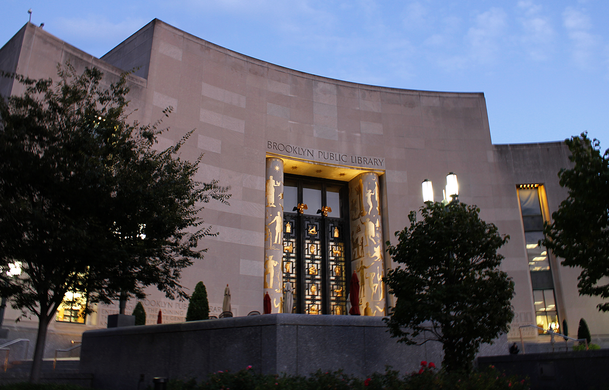AO Edited
Brooklyn Daily Eagle's Eagle
This metal eagle one of the final remnants of a newspaper that wanted to keep Brooklyn to Brooklyn.
The main entrance to Brooklyn’s Central Library at Grand Army Plaza is quite remarkable. An imposing 40-foot-high doorway of shining bronze, it is decorated with glittering Art Deco likenesses of famous American writers. But on the inside, above the doorway, and going mostly unnoticed by the thousands of daily library-goers, is a relic from the days when Brooklyn was one of the most thriving metropolises in the country. A colossal bronze eagle that used to adorn the doorway of what was once America’s most widely read newspaper: the Brooklyn Daily Eagle.
By the early 1880s, the once-independent Brooklyn had become the third-largest city in the United States, with a population greater than Boston, Washington, D.C., San Francisco, and even Chicago. The city’s principal newspaper was the Brooklyn Daily Eagle, which ran for 114 years, from its first edition on October 26th, 1841 until its demise in 1955.
From its original offices near the East River waterfront, on Old Fulton Street, it proudly championed Brooklyn’s civic identity, and with Walt Whitman as its editor, swiftly became the burgeoning city’s paper of record. As the paper grew in size and stature, the Eagle moved to the growing neighborhood of downtown Brooklyn near the new courthouses and Borough Hall, to a state-of-the-art building on the corner of Washington and Johnson streets.
The Eagle actively championed the building of the Brooklyn Bridge, and the day the bridge opened in 1883, the paper’s special edition broke all circulation records under the headline, “United! Brooklyn and New York by the Great Bridge.”
But cordial relations with New York quickly soured in the 1890s with the proposed merger of Brooklyn and Manhattan. The Eagle stood alone in the fight against what would become known as the “Mistake of 98.” The Eagle depicted Brooklyn as the cultured and far superior “city of homes and churches,” while painting Manhattan as the nefarious “city of Tammany Hall and Crime Government.” But despite its fierce and best efforts, Brooklyn was incorporated into the City of Greater New York, dropping in status from one of America’s largest cities to a mere borough. In its 1897 New Year’s Eve edition, the Eagle ran an obituary mourning “The Passing of the City of Brooklyn.”
Despite losing its cherished city status, the Eagle remained staunchly pro-Brooklyn in its outlook. In the handbook given to all new reporters, the message was clear; “Brooklyn First is a cardinal principal of Eagle policy. This newspaper is a Brooklyn institution. It is also a public service institution. Whatever helps Brooklyn helps the Eagle. The more you know about Brooklyn and about the Eagle, the better you will serve both.”
But following a drawn-out strike with the New York Newspaper Guild in 1955, financial difficulties saw the venerable newspaper finally close down, after 114 years without missing a daily edition.
The Eagle’s final editorial, on January 28th, 1955, laid the blame for the paper’s demise firmly at the feet of its rival across the East River; “Again Brooklyn falls victim to the Manhattan pattern. It has been that way since Brooklyn became a part of New York City… the Borough seems doomed to be cast in Manhattan’s shadow.”
But in the same year, as the Dodgers were leaving distraught Brooklynites for Los Angeles, the Central Library moved swiftly to buy the “morgue” of the Daily Eagle, containing its full archive of papers, as well as reports, almanacs, and editor’s files.
Today, housed in over 150 filing cabinets, the extraordinary resource is immaculately preserved and available free and online through the efforts of the Brooklyn Public Library. The entire run is able to be searched and explored, detailing the daily life and history of Brooklyn in the 19th and 20th centuries. The original Eagle building on Old Fulton Street still exists as a warehouse and storage building, and a local Brooklyn paper picked up the name when it fell into the public domain in the mid-1990s, although it remains unrelated to the old newspaper. The magnificent Eagle Building on Washington and Johnson Streets was demolished, along with Washington Street itself to make way for the Cadman Park.
As well as the archives, the Brooklyn Public Library also had the foresight to save the giant sculpted eagle that once proudly rested above the doorway of a now long gone newspaper. Or as the Eagle itself wrote in its final edition, “the last voice that is purely Brooklyn.”
In 2018 the library held a “name-the-eagle” contest. “Ingersoll” was the name that was selected, a tribute to Raymond Ingersoll, Brooklyn Borough President from 1934 to 1940. (The five borough presidents are the only county-wide elected officials in New York City.) Ingersoll pushed for the Central Library’s construction, calling the absence of a central library in Brooklyn “a great lack in the borough’s educational and cultural equipment [that] should not be tolerated in so great a community,” the library said when it announced the name.




















Follow us on Twitter to get the latest on the world's hidden wonders.
Like us on Facebook to get the latest on the world's hidden wonders.
Follow us on Twitter Like us on Facebook